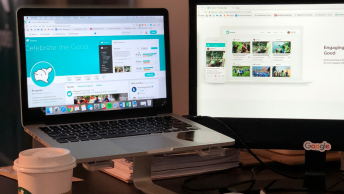It is possible to drive rankings and traffic with your content, you just need to know how to turn content marketing into context marketing. Your content is what your readers come back to you for; thus it is important to make sure that it has the right context. This is where context marketing becomes so important.
Turning Content Marketing into Context Marketing
At this point, it should come as no surprise that your content is important. Your content is what makes your brand, so it should be important to you.
What you might not have considered though is your context marketing. It is every bit as important as your content. Your context is what makes your content relevant and should be part of your digital branding strategy.
Ranking with Content Marketing
Content marketing is the foundation of every successful SEO campaign.
Getting your website to rank on Google is not about peppering your pages with one or two keywords. Google’s algorithms focus quality content that engages, builds trust, and establishes authority.
Google uses Latent Semantic Indexing (LSI) to determine whether to rank a page for a keyword or not. LSI allows Google to associate related words to a specific topic instead of simply relying on the appearance of specific keywords or phrases.
For example, Google can associate the phrases “golf bags” and “golf equipment” with the main keyword, “golf clubs”. Inserting these related keywords in your pages will make your website more relevant to users and consequently, Google will see your website as an authoritative website and index you appropriately, at the top of the SERP’s.
Writing for LSI requires more than just basic keyword research and writing. Your journalists and marketers need to combine creative writing skills with proven marketing strategies to develop content that impresses human audiences and search engines alike.
Writing and Marketing Blend
Being a good writer is not the same as being a good content marketer. Hence, a combination of writing and marketing skills is required to produce quality content for a website and for online campaigns.

Setting Solid Foundations through Writing
Developing good writing skills is the first step to becoming an effective content marketer. If you don’t know how to write well, readers won’t buy into your ideas no matter how much effort you put into marketing them.
By knowing how to write creatively, you can produce original content that informs and engages. Extensive storytelling skills can help you to write professional content for specific audiences with ease.
Achieving Business Goals with Marketing
Knowing the basics of marketing allows your writers to hone their writing style based on the industry standards and ethics. Their knowledge in marketing will allow them to develop and use content in a business context to sell your brand more effectively and help you gain more leads.
If their background is in writing and marketing, then your content team will know how to produce content that effectively targets specific niches, including:
- Arts & Entertainment Beauty
- Personal Care
- Business Education
- Home & Garden Hotels & Restaurants
- Industrial Law
- Real Estate
- Retail Apparel
- Food & Groceries Occasions & Gifts Services
- Sports & Fitness Travel & Tourism Technology
- Computers Consumer Electronics Internet & Telecoms
- Vehicles
- Family & Community Finance
- Health
- Dental Care
- Urgent Care
Six Types of Content
1. Press Release
Press releases allow you to make announcements about new products, services, or website features. Your press releases will help to increase brand awareness through authoritative news and information channels.
2. Downloadable ebooks, Guides, Infographics, and White Pages
These types of content provide in-depth information about industry- related topics. Offering eBooks, definitive guides, infographics, and white papers to your visitors will turn them into loyal customers.
3. E-newsletters

Electronic newsletters are publications meant to reach out to your readers directly via e-mail. Your newsletters contain company news, product or service announcements, or summaries or new content on your blog.
4. Videos and Webinars
With the rising popularity of video streaming websites and scripts, educational videos and webinars are becoming a valuable way of communicating with your users. Therefore the creative and memorable videos we produce will remind your audience that you are a reliable information resource.
5. On-Page Content
You should make sure the content that appears on your website’s pages are unique, relevant, and informative. Your on-page content helps create a richer user experience and encourages visitors to bookmark your site and keep coming back for more.
6. Informative Blog Posts or Magazine Articles
You should develop, write, and publish informative articles on internal or external blogs and online magazine sites. Your articles establish a good reputation for your brand by giving it a voice and personality.
Additionally, don’t think that you should restrict your content to only one or two types. Cross-marketing through different mediums and channels extends your brand’s reach, improves your link profile, and helps you understand your market’s behavior better.
Turning Content Marketing into Context Marketing
Search engine algorithms now mimic user experience better than ever. Creating keyword-based content is no longer good enough to give your website the online visibility it needs.
Including your target audience in your publishing house’s content development process is the key to context marketing.
SEE ALSO: Why Contextual Marketing is Important to Your Business
There are six key steps we take to apply context marketing to your campaign.
1. Prioritize Your Objectives
Determine what your long-term goals are for creating content. Do you want to make a sale, inform and educate, or start conversations? Defining your goals helps you to develop a content marketing strategy that suits your business’ specific goals.
2. Learn More About Your Market
Learning more about your audience helps you review our approach to content marketing. You can then determine what they want to find, how you can reach out to them effectively, and how you can convince them to take action. Work on creating content for people instead of search engines. Consequently, this will help you nurture long-lasting relationships with your target market.
3. Choose the Right Media
One of your most important tasks is to decide when, where, and how to publish your content. You should determine what type of content will communicate your message and attract more leads effectively, and publish it on a channel your target market can access easily.
4. Hone Your Content Using Topic Modeling
Apply topic modeling concepts to keyword selection and content creation processes. This allows you to create outlines for focused, relevant pieces of content that meet Google’s LSI requirements while at the same time, speaks to your audience.
5. Establish Your Authority
You can only establish your authority in an industry by gaining your audience’s trust. In order to do that you need to produce valuable content and developing relationships with both your readers and third-party publishers. Only publish external content in established online magazines that will give you more exposure and cement your authority in your niche.
6. Monitor Your ROI
Your investments and what you stand to regain through your content marketing strategy depends on your initial goals. Monitor your website’s traffic and other web analytics, including the number of times your content is shared. This allows you to realign your strategies as needed and helps you determine what kind of returns to expect and focus on next.
Publishing Process

Fine-tuned your processes to make sure your publishing house produces only the best for your site. Your content team collaborates with SEO teams to develop relevant topics, create great content, and distribute that content to the right audience through the most effective channels.
1. Keyword Research and Selection
Don’t stop at creating a list of high-traffic keywords to add to your content. Use topic modeling in your keyword selection process to choose the best keywords and group them together to help your content team produce relevant and targeted content.
2. Content Ideation
Go through a brainstorming process of identifying the most relevant topics based on the keyword maps and groups, and then decide which ones your brand’s target audience will resonate with the most. Therefore, your goal should be to either educate, inform, or entertain your audience.
3. Content Creation
While the quantity of content produced can certainly boost your traffic, we are very much focused on the quality of the content as well. Our content writers coordinate with our designers for content that requires fresh designs and layouts, like eBooks, whitepapers or infographics.
4. Content Editing
Each piece of content your writers produce needs to be sent to your editors for review and quality analysis. Get some experienced editors on your team to guide your writers and guarantee that the content your teams produce is ready for publication.
5. Content Approval
When your writers finish fine-tuning your content, it will be sent to you for approval. This is the time for you make any revisions you deem necessary before proceeding to publish.
6. Publishing
Only publish content after making sure everything is polished. On-page content, internal blogs, or anything that has gone through the approval process will be sent to you for upload, then you can get ready for responding to comments.
Final Thoughts
With the implementation of a good content strategy, you will see an increase in organic traffic to your website. This process takes dedication and focus; there are no shortcuts here. Your dedication will pay off though, with your brand soaring to new heights thanks to your content marketing turning into context marketing.











